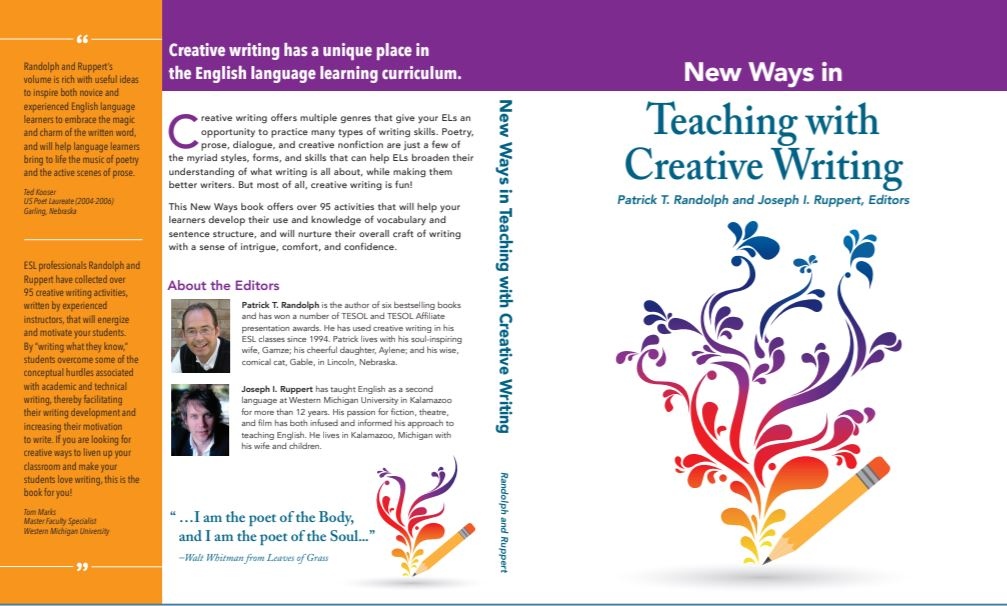|
| |
News Ways in Teaching with Creative WritingBy Patrick T. RandolphEditor's Note: This article was written by Patrick T. Randolph, one of our ITBE members and a frequent convention presenter. He writes about the book he recently co-edited with Joseph Ruppert, published by TESOL press. 
“I am the poet of the body,
And I am the poet of the soul.” —Walt Whitman
from Leaves of Grass New Ways in Teaching with Creative Writing, by Patrick T. Randolph and Joseph I. Ruppert, is the first book of its kind for the English Language Education Community. The co-editors hope the book will help teachers, students, materials writers, and ESL and EFL curriculum developers change the way writing is taught and perceived by making it a fun, creative, and user-friendly skill that everyone can develop and improve upon. The goal of the book is to show—through 97 different activities—how the techniques and genres used in creative writing can help English language learners (ELLs) enhance their academic, creative, and technical writing skills. New Ways in Teaching with Creative Writing has four sections: Poetry Activities, Prose Activities, Dialogue Activities, and Creative Writing Projects. Each category helps ELLs develop their understanding of word craft and deepen their critical and creative thinking skills. And, most important, students will enrich their writing skills because they are writing about what they know and playing with the ideas in a very intimate and personal way. This encourages the element of ownership more than any other kind of writing, and it inspires a true sense of motivation to write and learn about the whole writing process. In short, the book emphasizes and reinforces Randolph’s claim that creative writing is the most natural and helpful tool to inspire and enhance ELLs’ general thinking and writing skills in English. Another significant highlight of the book is that each activity includes either a student- or a teacher-generated sample. These example pieces are useful models for teachers to help guide their students through writing insightful poetry, prose, dialogue, and organizing creative writing projects with creativity, coherence, control, comfort, and confidence. A free online resource is also available for teachers and students. This offers a helpful glossary of useful terms, and it also includes extra materials and templates for completing some of the activities in the book. Randolph and Ruppert’s book has been endorsed by Ted Kooser, one of the most renowned U.S. Poet Laureates (2004-2006). In his testimonial, Kooser writes, “Randolph and Ruppert’s volume is rich with useful ideas to inspire both novice and experienced English language learners to embrace the magic and charm of the written word, and will help language learners bring to life the music of poetry and the active scenes of prose.”  New Ways in Teaching with Creative Writing is available on the TESOL Press website at http://sites.tesol.org/ItemDetail?iProductCode=14410&Category=NEWWAYS&WebsiteKey=62ea1393-07ea-402b-b723-0e66240ee86b and on Amazon at https://www.amazon.com/New-Ways-Teaching-Creative-Writing/dp/1942799861/ref=sr_1_3?dchild=1&keywords=Patrick+T.+Randolph&qid=1585707271&s=books&sr=1-3 Introduction and Three Sample Activities Below you will find the link to the introduction and the following three activities from the book: “Two-Perspective Poetry,” “Turning Lexical Items Into Word-People Poems,” and “Organizing a Public Poetry Event.” Please enjoy. Link: https://www.academia.edu/ Patrick T. Randolph specializes in vocabulary acquisition, creative and academic writing, speech, and debate. Patrick was awarded the “Best of the TESOL Affiliates” in 2017 for his 2016 presentation on plagiarism. He has also received two “Best of CoTESOL Awards” for his 2017 and 2018 presentations on observation journals and creative writing. Patrick lives with his wife, Gamze; daughter, Aylene; and cat, Gable, in Lincoln, Nebraska, USA. Image source: www.pixabay.com | |
| ITBE Link - Spring 2020 - Spring 2020 |